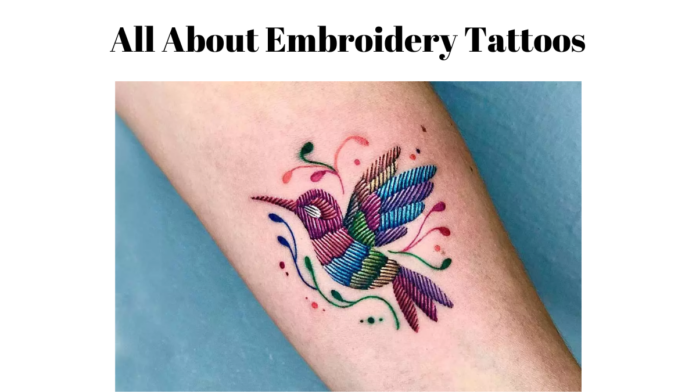Embroidery tattoo are a new and innovative style of tattooing that mimics the look of stitched fabric on the skin. They can create stunning 3D effects and combine traditional and modern art forms.
In this article, we will cover everything you need to know about embroidery tattoos, including Where they come from and who started them, What makes them unique and appealing, how they are done and what fits this style best, and some questions that you may want to ask:
Where Did Embroidery Tattoos Come From, and Who Started Them?
Embroidery tattoos were first seen in Latin America in 2017 and have become popular worldwide. One of the founders of this style is Eduardo Lozano, a Brazilian tattoo artist who works in São Paulo. He is famous for his realistic and accurate embroidery tattoos, often including cartoon characters, animals, and flowers. He also includes broken strings in his designs to give them a more realistic feel.
Other artists who have perfected this style include Ksu Arrow, Russell Van Shaick, and Fernanda Alvarez. They have designed stunning embroidery tattoos with themes ranging from nature to culture to fantasy.
What Makes Embroidery Tattoos Unique and Appealing?
Embroidery tattoos are special because they appear as if they are set on top of the skin rather than being a part of it. They make an impression of depth and texture by using various colours and strokes to imitate the effect of a needle and thread. They also combine two forms of art – tattooing and embroidery – that have a long and deep tradition.
Embroidery tattoos are attractive because they are innovative and flexible. They suit every taste and character because they can be implemented in different styles, sizes, and locations. Based on the design and symbolism of the embroidery, they can also have other messages and meanings.
How Are Embroidery Tattoos Done and What Fits This Style Best?
Embroidery tattoos are made using a tattoo machine and ink in the same way as any other tattoo. However, the technique and level of skill needed are different. The tattoo artist should clearly understand light and shadow, colour theory, and geometry. In addition, they must learn to make small and accurate strokes, which can be compared to the stitches of embroidery.
The design of the embroidery tattoo is also essential because it should be simple and clear enough to resemble a patch. The tattoo artist may employ a stencil or a hand technique to trace the outline of the design on the skin. Next, they colour in the design with various shades of different colours, giving the impression of depth and texture. Lastly, they include the details, including the border, the strings, and the shadows.
Some of the best designs for embroidery tattoos include nature-inspired ones, such as flowers, leaves, birds, and butterflies. They can provide a contrast between the natural and the artificial, as well as many symbolic meanings. Other common designs include culture-related ones, which include flags, logos, icons, and patterns.
They can display the wearer’s individuality and sense of belonging and are very beautiful. Lastly, some of the most imaginative designs are inspired by fantasy, including dragons, unicorns, and fairies. They can show the wearer’s creativity and character, and they can be very entertaining and amusing.
Some Questions
What are embroidery tattoos?
Embroidery tattoos are a style of tattooing that mimics the appearance of embroidered fabric with stitches, threads, and patches. They are created with multiple ink colours and small needles to create the illusion of depth and texture.
Who are some of the pioneers of embroidery tattoos?
Some of the most talented and popular tattoo artists specialising in embroidery tattoos are Eduardo “Duda” Lozano from Brazil, Ksu Arrow from Russia, Russell Van Shaick from the USA, and Fernanda Alvarez from Mexico.
What are some of the best designs for embroidery tattoos?
Different sources, such as classical art, traditional motifs, cartoon characters, video game icons, floral patterns, and more, can inspire embroidery tattoos. Some of the most common designs are badges, logos, patches, and symbols that look sewn or ironed on the skin.

















